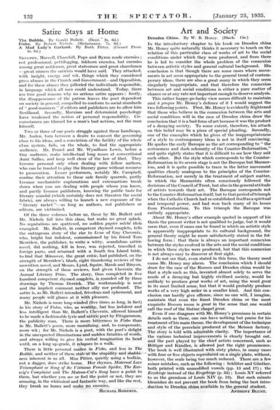IN the introductory chapter to his book on Dresden china
Mr. Honey quite naturally thinks it necessary to touch on the relation of this particular class of works of art to the social conditions under which they were produced, and from there he is led to consider the whole problem of the connexion between artistic styles and general cultural background. His conclusion is that though there are some cases where move- ments in art seem appropriate to the general trend of contem- porary ideas, there are also a great many in which they seem singularly inappropriate, and that therefore the connexion between art and social conditions is either a pure matter of chance or at any rate not important enough to deserve analysis.
This rather happy-go-lucky view seems difficult to maintain
and a propos Mr. Honey's defence of it I would suggest the two following points. First, Mr. Honey is evidently frightened that those who believe in the connexion between the arts and social conditions will in the case of Dresden china draw the conclusion that it is a bad form of art because it was the product of a decaying society. To some extent, therefore, his attack on this belief may be a piece of special pleading. Secondly, one of the examples which he gives of the inappropriateness of a style to contemporary ideas is not in itself convincing. He quotes the early Baroque as the art corresponding to " the seriousness and dark solemnity of the Counter-Reformation," and quite rightly states that it is difficult to see how they suit each other. But the style which corresponds to the Counter- Reformation in its severe stage is not the Baroque but Manner- ism, and it is quite possible to trace in the latter movement qualities closely analogous to the principles of the Counter- Reformation, not merely in the treatment of subject matter, in which the Mannerists often consciously followed the decisions of the Council of Trent, but also inthe general attitude of artists towards their art. The Baroque corresponds not to the Counter-Reformation itself, but to that period of triumph when the Catholic Church had re-established itself as a spiritual and temporal power, and had won back many of its losses from Protestantism. To this triumph the Baroque was entirely appropriate.
About Mr. Honey's other example quoted in support of his
thesis the present writer is not qualified to judge, but it would seem that, even if cases can be found in which an artistic style is apparently inappropriate to its cultural background, the general theory might be more satisfactorily stated in the fol- lowing form : that there is always an important connexion between the styles evolved in the arts and the social conditions in which these styles were produced, but that this connexion is not always easy to discover at first sight.
I do not see that, even stated in this form, the theory need
cause Mr. Honey any alarm. The conclusion which I should draw for the case of the Rococo and Dresden china would be that a style such as this, invented almost solely to serve the needs of a decaying but highly civilized society, would be unlikely to produce great works of art, using the word great in its most limited sense, but that it would probably produce works of a very high order in a smaller kind. And this con- clusion can hardly give offence, since no one will, I imagine, maintain that even the finest Dresden china or the most exquisite Rococo room is great in the sense that one would call the roof of the Sistine chapel great.
Even if one disagrees with Mr. Honey's premisses in certain
details such as these, one can have nothing but praise for his treatment of his main theme, the development of the technique and style of the porcelain produced at the Meissen factory. The story is told with admirable clarity. The importance of the various technical improvements is clearly brought out, and the part played by the chief artists concerned, such as Blittger and Kindler, is allowed just the right- prominence. The book is well illustrated with sixty plates, in many cases with four or five objects reprodueed on a single plate, without, however, the scale being too much reduced. There are a few minor mistakes, such as the following : Schliiter and Gunther, both printed with unmodified vowels (pp. 15 and 17) ; the Erzebirge instead of the Erzgebirge (p. 82) ; Louis XV referred to as the grandson of Louis XIV (p. 19). But such minute blemishes do not prevent the book from being the best intro- duction to Dresden china available to the general student.
ANTHONY BLUNT.














































 Previous page
Previous page